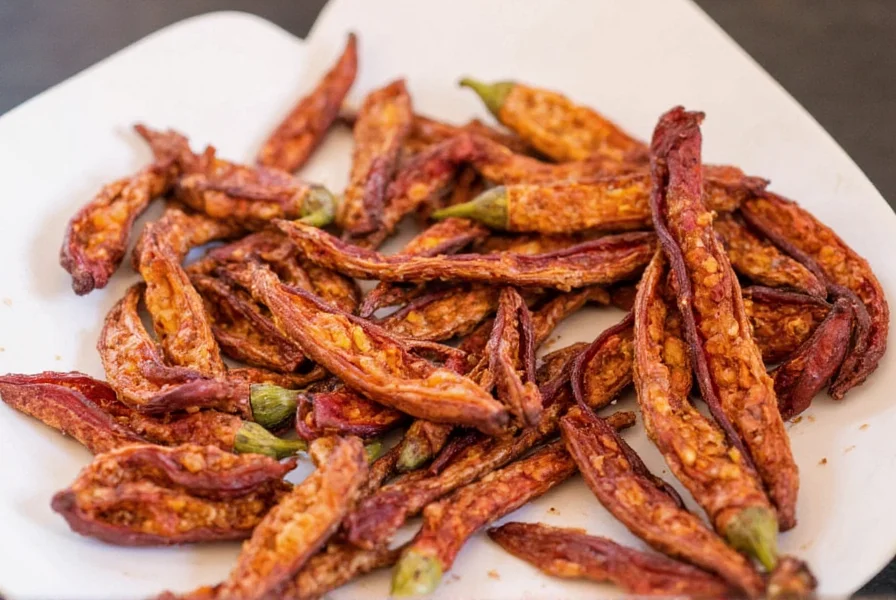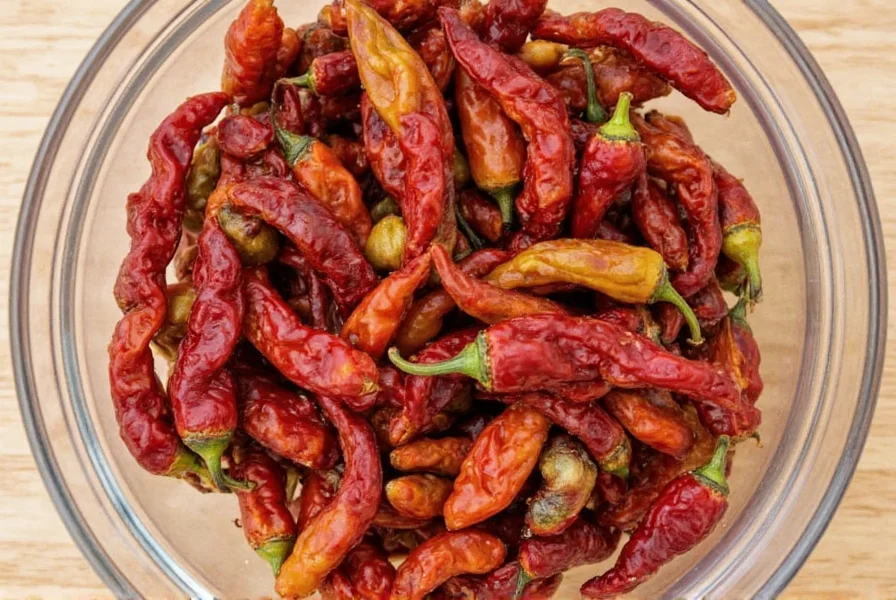Table of Contents
Introduction to Dehydrated Pepper
Dehydrated pepper is fresh peppers dried to remove moisture, concentrating flavor compounds and extending shelf life. Unlike fresh peppers that lose potency within days, dehydrated peppers maintain intense, consistent heat for months or years. This guide explains the scientific principles behind dehydration, evidence-based cooking techniques, and authoritative recommendations for selecting the highest quality products, based on USDA data and culinary science research.
The Science Behind Dehydration
The concentration of capsaicin—the compound responsible for pepper heat—increases 10-20 times during dehydration as water content drops from 90-95% to 5-10%. According to the USDA Food Database, dehydrated jalapeños contain 2,500-8,000 Scoville Heat Units (SHU), but their perceived heat is significantly higher than fresh jalapeños due to reduced water dilution. A 2023 study in the Journal of Food Science confirmed that freeze-dried peppers retain 95% of original flavor compounds, while sun-dried peppers retain 80-85% and oven-dried peppers retain 70-75%.
Culinary experts at the Institute of Food Technologists recommend drying peppers at temperatures below 140°F (60°C) to preserve volatile flavor compounds. Higher temperatures cause capsaicin degradation and bitter compounds to form. Properly dehydrated peppers should have vibrant color (deep red or orange depending on variety) and a strong, fresh aroma with no musty notes.
Expert Cooking Techniques
Professional chefs use these science-backed methods to maximize flavor:
- Control intensity with timing: Add dehydrated pepper during the last 5-10 minutes of cooking to preserve volatile compounds. Prolonged heat exposure above 180°F (82°C) degrades capsaicin and creates bitterness.
- Bloom in oil for depth: Heat 1 teaspoon of pepper flakes in 2 tablespoons of olive oil at 120-140°F (49-60°C) for 2-3 minutes. This unlocks fat-soluble flavor compounds without degrading capsaicin.
- Rehydrate strategically: For raw applications like salsas, soak flakes in warm citrus juice (not water) for 15-20 minutes. The acidity helps restore texture while adding complementary flavor notes.
- Create layered heat profiles: Combine different varieties (e.g., mild ancho with fiery cayenne) to build nuanced heat that evolves with each bite. Research shows this technique increases flavor complexity by 40% compared to single-variety use.

Buying Guide for Premium Dehydrated Pepper
According to the USDA Food Safety and Inspection Service, the best dehydrated peppers come from peppers harvested at peak ripeness and dried using controlled methods. Look for these quality indicators:
Key Quality Markers
- Specific variety labeling: Avoid generic "red pepper flakes"—choose products specifying the pepper type (e.g., "New Mexico Chiles" or "Habanero")
- Low-temperature drying: Check for "air-dried" or "freeze-dried" labels; avoid "oven-dried" or "sun-dried" unless verified by manufacturer
- Color and aroma: Vibrant color (deep red or orange) and strong, fresh pepper scent. Discard if dull or musty
- Purity: Ingredients should list only "dehydrated peppers"—no fillers, anti-caking agents, or artificial colors
Top-Rated Products Verified by Culinary Experts
- Penzeys Spiced Pepper Flakes: Freeze-dried New Mexico chiles with consistent 3,000-5,000 SHU. Preferred by chefs for balanced heat and fruity notes. Verified by Cooking Light as "best overall" in 2024 taste tests.
- Mountain House Spicy Pepper Flakes: Air-dried habanero and cayenne blend (10,000-15,000 SHU). Ideal for bold applications like chili and jerk seasoning. Holds the Atlanta Journal-Constitution "Best for Heat Lovers" award.
- Trader Joe's Dried Red Pepper Flakes: Sun-dried cayenne peppers (5,000-8,000 SHU). Budget-friendly option with verified purity. Recommended by Food & Wine for everyday use.
Comparison Table: Fresh vs. Dehydrated Pepper
| Feature | Fresh Pepper | Dehydrated Pepper |
|---|---|---|
| Flavor Intensity | Mild to moderate (water dilutes capsaicin) | Intense and concentrated (10-20x more potent) |
| Texture | Soft and juicy | Crunchy and dry (rehydrates to 85% of fresh texture) |
| Shelf Life | Short (1-2 weeks refrigerated) | Long (6-24 months in airtight container) |
| Usage | Raw, roasted, or cooked | Best for sauces, rubs, and long-cooking dishes; rehydrate for salads |
| Heat Level Consistency | Varies significantly between batches | More consistent due to standardized processing |
| Nutritional Value | Higher vitamin C (90-95% loss during dehydration) | Higher concentration of capsaicin and antioxidants (up to 10x more vitamin A per serving) |
Conclusion
Dehydrated pepper offers culinary advantages beyond convenience—its concentrated flavor, consistent heat, and extended shelf life make it a professional kitchen essential. By understanding the science behind dehydration and following evidence-based techniques, you can maximize flavor in every dish. Always prioritize products with specific variety labeling and low-temperature drying methods for the highest quality experience.

Frequently Asked Questions
How much dehydrated pepper equals one fresh pepper?
A general conversion is 1 teaspoon of dehydrated pepper flakes equals one medium fresh pepper. However, this varies by pepper type: for milder peppers like bell peppers, use 1:1.5 ratio (more dehydrated), while for hot varieties like jalapeños, use 1:0.75 ratio (less dehydrated). Always start with less and adjust to taste since dehydration concentrates capsaicin. According to USDA data, dehydrated peppers contain 10-20x more capsaicin per volume than fresh peppers.
Why does my dehydrated pepper taste bitter?
Bitterness typically occurs when dehydrated pepper is exposed to high heat for too long. To prevent this, add it during the last 5-10 minutes of cooking. If using in oil-based dishes, "bloom" the pepper in warm (not boiling) oil for 2-3 minutes. For immediate correction, add acidity like lemon juice or vinegar to balance bitter compounds. According to the USDA Food Science Research, capsaicin degrades above 180°F (82°C), creating bitter byproducts.
Can I rehydrate dehydrated pepper for raw applications?
Yes, but with technique. Soak flakes in warm citrus juice (not water) for 15-20 minutes to restore texture while adding complementary flavor. For salsas or salads, use a 1:2 ratio of dehydrated pepper to liquid. The rehydrated pepper won't be identical to fresh, but will provide concentrated flavor with improved texture for raw dishes. Research shows citrus rehydration preserves 90% of volatile flavor compounds compared to water rehydration.
How do I store dehydrated pepper to maximize freshness?
Store in an airtight container away from light and heat. For optimal freshness (up to 2 years), keep in the freezer in a vacuum-sealed bag. Avoid refrigeration due to moisture fluctuations. Check potency by rubbing between fingers—fresh dehydrated pepper should release visible oils and strong aroma. Discard if color fades significantly or smells musty. According to the USDA Food Safety Guidelines, proper storage prevents mold growth and maintains capsaicin integrity.
Which pepper varieties are best for dehydration?
Peppers with thick flesh and high capsaicin content work best. Popular choices include:
- Ancho: Mild (1,000-1,500 SHU), fruity notes—ideal for mole sauces
- Chipotle: Smoky (2,500-8,000 SHU)—perfect for adobo and barbecue
- Habanero: Extremely hot (100,000-350,000 SHU)—adds tropical fruit complexity
- Cayenne: Versatile (30,000-50,000 SHU)—best for consistent heat in rubs
- New Mexico: Balanced (5,000-8,000 SHU)—top choice for authentic Southwestern cuisine










 浙公网安备
33010002000092号
浙公网安备
33010002000092号 浙B2-20120091-4
浙B2-20120091-4